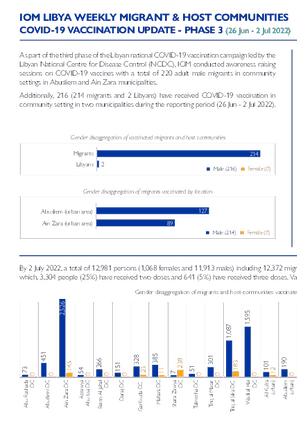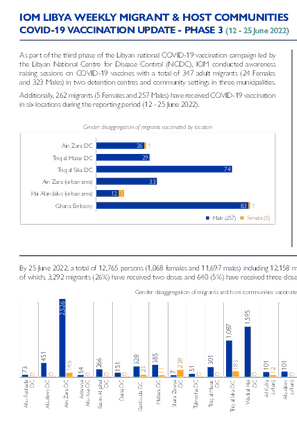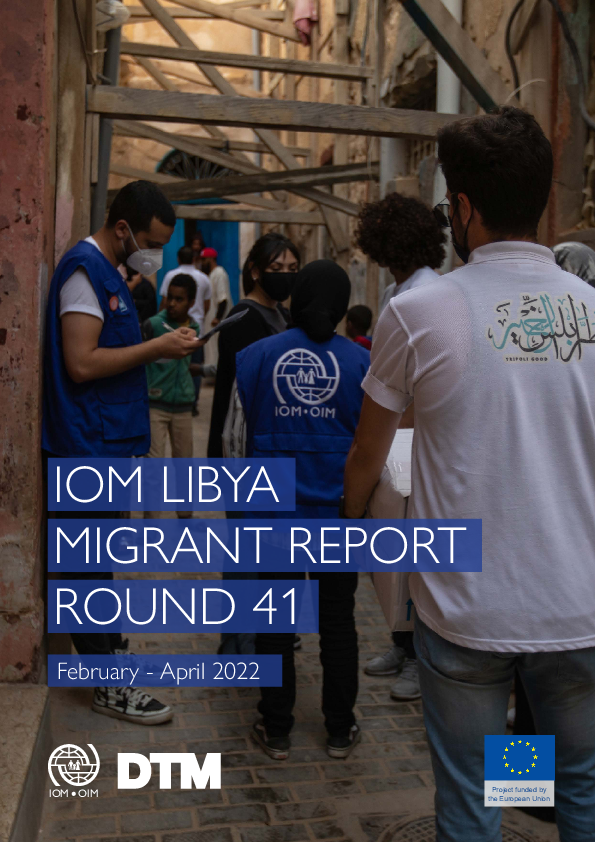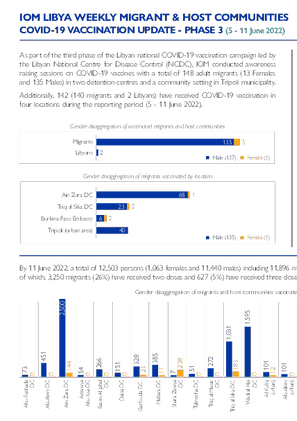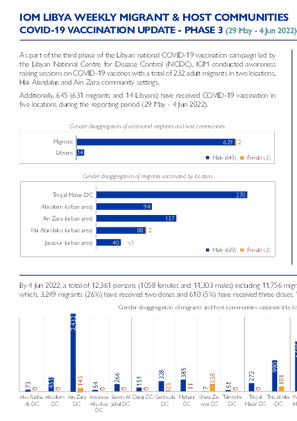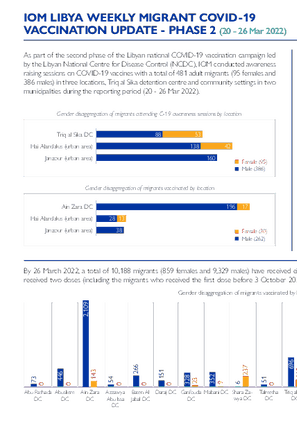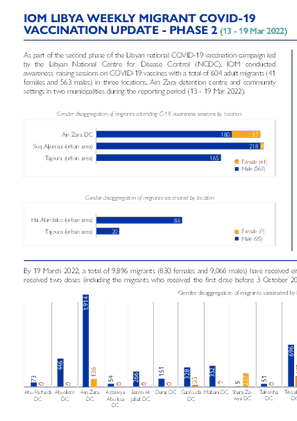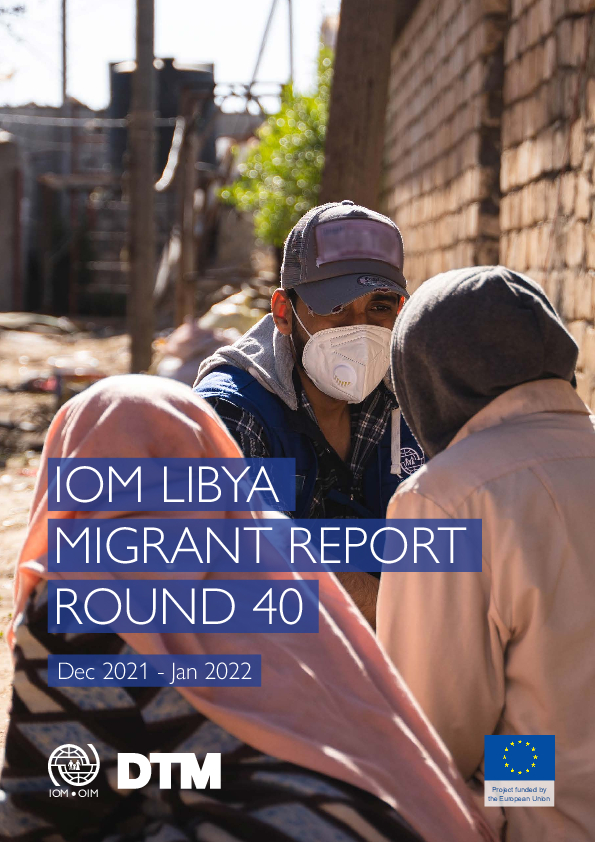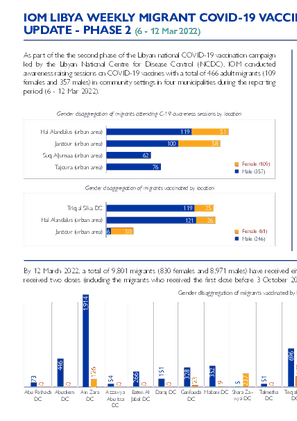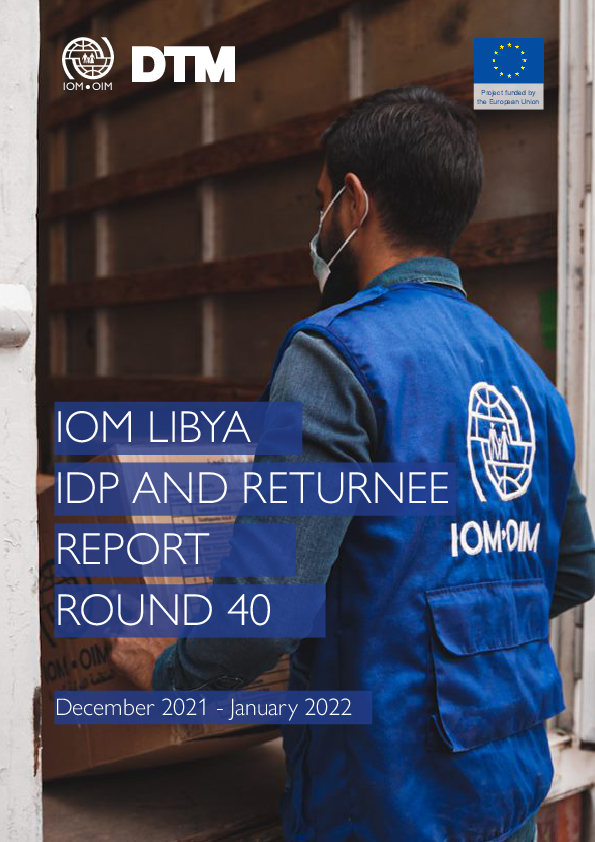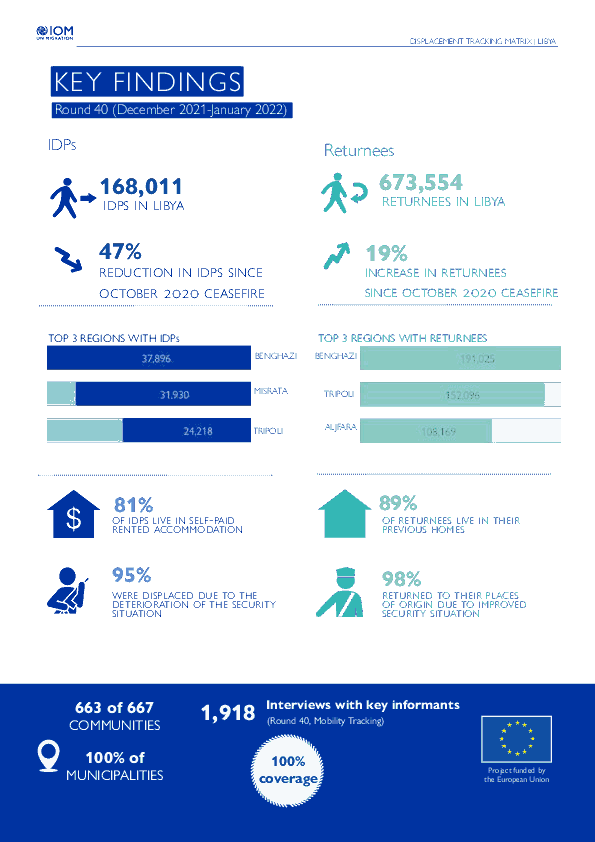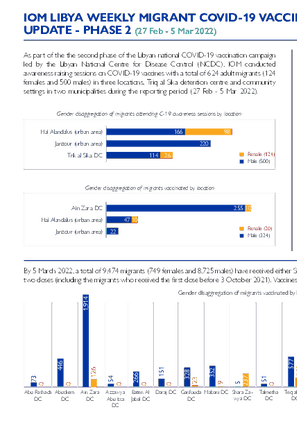-
Countries
-
Data and Analysis
-
Special Focus
-
Crisis Responses
Libya
Error message
The submitted value field_published_date_value in the Sort by element is not allowed.
About Libya
Libya is a geographically vast country with several regions that are difficult to access. In order to understand the full scope of humanitarian assistance that is needed throughout the country, IOM established the Displacement Tracking Matrix (DTM) programme in 2016 in order to provide a common operating picture concerning the movement of populations in Libya, allowing humanitarian actors to provide timely assistance to those in need. Following the escalation of conflict and insecurity in 2014, the security situation has remained volatile since with fluctuations in the intensity of localized clashes. Congruently, conflict has caused new displacements, often in areas ill-equipped to accommodate large population movements while also negatively impacting the large migrant population residing and transiting through Libya. More recently, the capital Tripoli was heavily affected by displacement waves in September 2018 and April 2019.
DTM’s mobility tracking and flow monitoring activities identified many migrants in-country to be in need of various forms of assistance. Libya’s geographic location, resources and work opportunities has made it both a country of destination and transit for migrants for many years. Despite the deterioration of the security situation since 2011 migrants continue coming to and transiting through Libya, the majority from Sub-Saharan and North African countries.
In this complex operating environment, DTM Libya has been providing a common operating picture concerning the movement of populations in Libya since 2016, allowing humanitarian actors to provide timely assistance to those in need. Through its mobility tracking, flow monitoring and needs assessment activities, DTM Libya has established itself as data hub for quantitative data on migratory flows to and within Libya, migrant presence in Libya disaggregated by nationality and area, as well as humanitarian needs of migrants, internally displaced population and returnees. All activities are implemented through periodical bi-monthly data collection cycles, allowing trend analysis over time to provide evidence-base for both policy-level discussions and to guide humanitarian action.
In order to facilitate humanitarian interventions, DTM works closely with IOM’s other programmes through referring identified populations in need of assistance at flow monitoring points to IOM’s Direct Assistance, Health, Voluntary Humanitarian Return (VHR), Protection and Migrant Rapid Response Mechanism (MRRM) programmes. Furthermore, DTM Libya supports other humanitarian partners through providing emergency tracking updates in case of sudden population movements as well as facilitating humanitarian assessments for the Rapid Response Mechanism (RRM) jointly implemented by IOM, UNICEF, WFP and UNFPA.
For more information on IOM's activities in Libya, please visit the IOM Libya country office website.
Contact
DTM Libya
DTMLibya@iom.int
Current Donors
- EUTF
Libya — Detention Centre Profile Generator (June 2022)
Detention Centre Profiling is a component of IOM Libya’s Displacement Matrix programme. It is a data oriented tool that routinely provides specific sex and age demographic data and key sectoral information on individuals held in Libya’s detention centres on the date of assessment.
Libya — Weekly Migrant and Host Communities COVID-19 Vaccination Update - Phase 3 (26 Jun - 2 Jul 2022)
As part of the third phase of the Libyan national COVID-19 vaccination campaign led by the Libyan National Centre for Disease Control (NCDC), IOM conducted awareness raising sessions on COVID-19 vaccines with a total of 220 adult male migrants in community settings in Abusliem and Ain Zara munici
Libya — Migrant Report 41 (Feb - April 2022) [ARABIC]
خلال ما بين شهري فبراير وأبريل من سنة 2022، أحصت مصفوفة تتبع النزوح في ليبيا وجود إجمالي 788.649 مهاجرا ينحدر أصلهم من أكثر من 41 جنسية في بلديات ليبيا الـ100 وفي إطار الجولة 41 من تجميع البيانات.
Libya — Weekly Migrant and Host Communities COVID-19 Vaccination Update - Phase 3 (12 - 25 June 2022)
As part of the third phase of the Libyan national COVID-19 vaccination campaign led by the Libyan National Centre for Disease Control (NCDC), IOM conducted awareness raising sessions on COVID-19 vaccines with a total of 347 adult migrants (24 Females and 323 Males) in two detention centres and co
Migrant Report Key Findings Round 41 (Feb - April 2022)
This infographic presents the key findings of Round 41 of the mobility tracking component of the Displacement Tracking Matrix (DTM) programme in Libya.
Libya — Migrant Report 41 (Feb - April 2022)
IOM Libya’s Displacement Tracking Matrix (DTM) programme identified a total of 649,788 migrants from over 41 nationalities in the 100 Libyan municipalities during Round 41 of data collection (February - April 2022).
Jun 20 2022
Libya — Migrant Report 41 (Feb - April 2022)
Libya — Weekly Migrant and Host Communities COVID-19 Vaccination Update - Phase 3 (5 - 11 June 2022)
As part of the third phase of the Libyan national COVID-19 vaccination campaign led by the Libyan National Centre for Disease Control (NCDC), IOM conducted awareness raising sessions on COVID-19 vaccines with a total of 148 adult migrants (13 Females and 135 Males) in two detention centres and a
Libya — Weekly Migrant and Host Communities COVID-19 Vaccination Update - Phase 3 (29 May - 4 Jun 2022)
As part of the third phase of the Libyan national COVID-19 vaccination campaign led by the Libyan National Centre for Disease Control (NCDC), IOM conducted awareness raising sessions on COVID-19 vaccines with a total of 232 adult migrants in two locations, Hai Alandalus and Ain Zara community set
Libya — Detention Centre Profile Generator (May 2022)
Detention Centre Profiling is a component of IOM Libya’s Displacement Matrix programme. It is a data oriented tool that routinely provides specific sex and age demographic data and key sectorial information on individuals held in Libya’s detention centres on the date of assessment.
Libya — Weekly Migrant and Host Communities COVID-19 Vaccination Update - Phase 3 (18 - 28 May 2022)
As part of the third phase of the Libyan national COVID-19 vaccination campaign led by the Libyan National Centre for Disease Control (NCDC), IOM conducted awareness raising sessions on COVID-19 vaccines with a total of 1150 adult migrants in six locations, Triq al Sika, Triq al Matar, and Ain Za
Libya — Detention Centre Profile Generator (April 2022)
Detention Centre Profiling is a component of IOM Libya’s Displacement Matrix programme. It is a data oriented tool that routinely provides specific sex and age demographic data and key sectorial information on individuals held in Libya’s detention centres on the date of assessment.
Libya — IDP and Returnee Report 40 (December 2021 - January 2022) [Arabic]
يعرض تقرير مصفوفة تتبع النزوح الخاصّة بالمنظمة الدولية للهجرة البيانات والمستخلصات حول النازحين داخليا والعائدين فيما بين شهري ديسمبر من سنة 2021 وشهر يناير من سنة 2022 وفي إطار الجولة 40 من تتبع التنقل في ليبيا.
Libya — Detention Centre Profile Generator (March 2022)
Detention Centre Profiling is a component of IOM Libya’s Displacement Matrix programme. It is a data oriented tool that routinely provides specific sex and age demographic data and key sectorial information on individuals held in Libya’s detention centres on the date of assessment.
Libya — Weekly Migrant COVID-19 Vaccination Update - Phase 2 (27 Mar - 2 Apr 2022)
As part of the second phase of the Libyan national COVID-19 vaccination campaign led by the Libyan National Centre for Disease Control (NCDC), IOM conducted awareness raising sessions on COVID-19 vaccines with a total of 44 adult migrants (21 females and 23 males) in a community setting in Hai Al
Libya — Weekly Migrant COVID-19 Vaccination Update - Phase 2 (20 - 26 Mar 2022)
As part of the second phase of the Libyan national COVID-19 vaccination campaign led by the Libyan National Centre for Disease Control (NCDC), IOM conducted awareness raising sessions on COVID-19 vaccines with a total of 481 adult migrants (95 females and 386 males) in three locations, Triq al Si
Libya — Weekly Migrant COVID-19 Vaccination Update - Phase 2 (13 - 19 Mar 2022)
As part of the third phase of the Libyan national COVID-19 vaccination campaign led by the Libyan National Centre for Disease Control (NCDC), IOM conducted awareness raising sessions on COVID-19 vaccines with a total of 604 adult migrants (41 females and 563 males) in three locations, Ain Zara de
Migrant Report Key Findings Round 40 (Dec 2021 - Jan 2022)
This infographic presents the key findings of Round 40 of the mobility tracking component of the Displacement Tracking Matrix (DTM) programme in Libya.
Libya — Migrant Report 40 (Dec 2021 - Jan 2022)
DTM Libya identified a total of 635,051 migrants from over 44 nationalities in the 100 Libyan municipalities during Round 40 of data collection (December 2021 – January 2022).
Mar 16 2022
Libya — Migrant Report 40 (Dec 2021 - Jan 2022)
Libya — Weekly Migrant COVID-19 Vaccination Update - Phase 2 (6 - 12 Mar 2022)
As part of the the second phase of the Libyan national COVID-19 vaccination campaign led by the Libyan National Centre for Disease Control (NCDC), IOM conducted awareness raising sessions on COVID-19 vaccines with a total of 466 adult migrants (109 females and 357 males) in community settings in
Libya — IDP and Returnee Report 40 (December 2021 - January 2022)
This IOM Displacement Tracking Matrix (DTM) report presents the data and findings on internally displaced persons (IDPs) and returnees between December 2021 – January 2022, representing round 40 of the DTM Mobility Tracking in Libya.
Libya — IDP and Returnee Key Findings Report 40 (December 2021 - January 2022)
This infographic presents the key findings of Round 40 of the mobility tracking component of the Displacement Tracking Matrix (DTM) programme in Libya.
Libya — Detention Centre Profile Generator (February 2022)
Detention Centre Profiling is a component of IOM Libya’s Displacement Matrix programme. It is a data oriented tool that routinely provides specific sex and age demographic data and key sectorial information on individuals held in Libya’s detention centres on the date of assessment.
Libya — Weekly Migrant COVID-19 Vaccination Update - Phase 2 (27 Feb - 5 Mar 2022)
As part of the the second phase of the Libyan national COVID-19 vaccination campaign led by the Libyan National Centre for Disease Control (NCDC), IOM conducted awareness raising sessions on COVID-19 vaccines with a total of 624 adult migrants (124 females and 500 males) in three locations, Triq
Libya — Migrant Report 39 (October - November 2021) [Arabic]
في إطار الجولة 39 من تجميع البيانات على مدى شهري أكتوبر ونوفمبر من سنة 2021، أحصت مصفوفة تتبع النزوح وجود إجمالي 621.007 مهاجرا في 100 بلدية في ليبيا ينحدر أصلهم من أكثر من 43 جنسية. استمرّ عدد المهاجرين في الارتفاع خلال الفترة المشمولة بالتقرير على نفس منوال النّسق الذي بدأ في مطلع سنة 2021.
Pagination
Libya - IDPs and Returnees Baseline Assessment Round 10
2017-05-30
A baseline assessment is a sub-component of mobility tracking. It aims to collect data on IDP, migrant or returnee population presence in a defined administrative area of the country.
Libya - Migrant Baseline Assessment Round 10
2017-04-30
A baseline assessment is a sub-component of mobility tracking. It aims to collect data on migrant population presence in a defined administrative area of the country.
Libya - Migrant Baseline Assessment Round 9
2017-04-30
A baseline assessment is a sub-component of mobility tracking. It aims to collect data on migrant population presence in a defined administrative area of the country.
Libya - Migrant Baseline Assessment Round 8
2017-03-31
A baseline assessment is a sub-component of mobility tracking. It aims to collect data on migrant population presence in a defined administrative area of the country.
Libya - IDPs and Returnees Baseline Assessment Round 9
2017-03-31
A baseline assessment is a sub-component of mobility tracking. It aims to collect data on IDP, migrant or returnee population presence in a defined administrative area of the country.
Libya - IDPs and Returnees Baseline Assessment Round 8
2017-02-28
A baseline assessment is a sub-component of mobility tracking. It aims to collect data on IDP, migrant or returnee population presence in a defined administrative area of the country.
Libya - IDPs and Returnees Baseline Assessment Round 7
2016-12-31
A baseline assessment is a sub-component of mobility tracking. It aims to collect data on IDP, migrant or returnee population presence in a defined administrative area of the country.
Libya - IDPs and Returnees Baseline Assessment Round 6
2016-09-30
A baseline assessment is a sub-component of mobility tracking. It aims to collect data on IDP, migrant or returnee population presence in a defined administrative area of the country.
Libya - IDPs and Returnees Baseline Assessment Round 5
2016-08-31
A baseline assessment is a sub-component of mobility tracking. It aims to collect data on IDP, migrant or returnee population presence in a defined administrative area of the country.
Libya - IDPs and Returnees Baseline Assessment Round 4
2016-06-30
A baseline assessment is a sub-component of mobility tracking. It aims to collect data on IDP, migrant or returnee population presence in a defined administrative area of the country.
Libya - IDPs and Returnees Baseline Assessment Round 3
2016-05-31
A baseline assessment is a sub-component of mobility tracking. It aims to collect data on IDP, migrant or returnee population presence in a defined administrative area of the country.
Libya - IDPs and Retunrees Baseline Assessment Round 2
2016-03-31
A baseline assessment is a sub-component of mobility tracking. It aims to collect data on IDP, migrant or returnee population presence in a defined administrative area of the country.
Libya - IDPs and Returnees Baseline Assessment Round 1
2016-01-31
A baseline assessment is a sub-component of mobility tracking. It aims to collect data on migrant population presence in a defined administrative area of the country.
Pagination
- First page
- Previous page
- 1
- 2
- 3
- 4
- 5


